Getting to Know Ourselves through Global Literature
Laura Fuhrman
In 2011-2012 our Learning Community at Pot Spring Elementary School in Timonium, Maryland, focused on the intercultural understandings young children develop about themselves, others, and the world through experiences with global literature and how the children express their understandings through art. For an overview of our literacy community and school community, please see the first vignette in this issue, “Learning about Ourselves and Others through Global Literature.” We started the year helping our students understand themselves as cultural beings so they developed an appreciation of the role culture plays in their own lives, as well as the lives of others. As Short and Thomas (2011) state, focusing on personal cultural identities encourages students “to realize they have a perspective and to value the role that culture plays in their own lives and worldviews in order to understand why culture matters to others” (p. 155).
In this vignette I share how my students and I explored our cultural identities. To contextualize this focus, I begin by discussing some of the books we read. Then I examine my students’ responses in art and writing to Sebastian’s Roller Skates (de Deu Prats, 2005) in more detail.
Understanding Who We Are
In the fall my class and I read and discussed books in the text set on identity (A sampling is found in the chart). After reading a story, my students usually responded first in their sketchbooks by drawing and writing about their thoughts and what they considered to be the ‘big idea’ and meaning of the story. Students shared their art and writing as we discussed the story further.
|
Title / Author |
Aspect of Identity |
Art |
|
The Featherless Chicken by C. Chen (Taiwan) |
Accept and be proud of who you are; don’t judge yourself or others by outer appearances |
|
|
Suki’s Kimono by C. Uegaki Illus. by S. Jorisch (Canada) |
Be yourself despite what others think and stand up for what you believe |
|
|
Guji Guji by C. Chen (Taiwan)
|
Be yourself despite what others think and stand up for what you believe |
|
|
You Be Me, I’ll Be You by P. Mandelbaum (France) |
Accept and be proud of who you are; don’t judge yourself or others by outer appearances |
|
|
Those Shoes by M. Boelts Illus. by N. Jones (Urban Area) |
Being confident in who you are and putting others’ needs before your own |
|
|
Sam and the Lucky Money by K. Chinn Illus. by C. Van Wright & Y. Hu (Chinese Americans) |
Being confident in who you are and putting others’ needs before your own |
|
|
Pedrito’s Day by L Garay (Nicaragua) |
Being confident in who you are and putting others’ needs before your own |
|
Table 1. Selected Books from the Identity Text Set (Download in Word)
We read and discussed a range of books. For example, Pedrito’s Day (Garay, 1997) is the story of a young boy who is saving the money he earns by shining shoes to buy a bicycle. When he loses Tia Blanca’s money while running an errand for her, he decides to give his bike money to Tia Blanca. My students loved the story but were sad for Pedrito. In his sketchbook, Jason wrote “[Pedrito] did what he had to do. He replaced the money [with] the money he was using for the bike.” Avery wrote, “He was brave. He told the truth.”
Sam and the Lucky Money (Chinn, 1997) is another book my students enjoyed. In this story Sam receives money for the Chinese New Year and is faced with the challenge of spending his money wisely. In the end he gives his money to a homeless man in order for him to buy some socks. My children were fascinated with the homeless man and how caring Sam was by helping the man. Ava wrote in her sketchbook, “[Sam] gave his money to him and told him he can get some socks. Sam is the lucky one because he has money and his family.”
In The Featherless Chicken (Chen, 2006), a chicken born without feathers is looked down upon by other chickens who have feathers. In the end, all of the chickens laugh and play together and accept each other for who they are. My students didn’t have a problem understanding the message in the story about outer appearances. Tytianna, for example, wrote in her sketchbook, “He was sad because he did not have feathers like the others. Then they just did not care because they were having fun.”
As we read and discussed each story in the identity text set, as a class we created character x-rays (adapted from cultural x-rays in Short, 2009) for the main characters. I felt that creating these x-rays together about the characters would help my students understand that identities are complex and involve inner values and feelings as well as outer characteristics. To create the character x-rays following a story, students suggested visible physical characteristics of the person which I drew/wrote around the outside of the x-ray and what was important and what the person valued which I wrote on the inside the person’s heart.
Sebastian’s Roller Skates
Sebastian’s Roller Skates (de Deu Prats, 2005) was my students’ favorite book. It is the story of bashful Sebastian who wants desperately to communicate with others but is too shy to speak. The artist, Francesc Rovira, represents Sebastian’s numerous shy thoughts in thought bubbles made of a collage of black and white pieces of paper/newspaper. Just by chance Sebastian learns to roller skate which builds up his self-confidence and he begins to speak. Rovira shows these thoughts and speech in a collage of brightly colored pieces of paper. As a class we spent time discussing the mood found in the illustrations and how Rovira represents changes in that mood from the beginning to the end of the story with collages of newspaper and colored construction paper.
Because Sebastian’s Roller Skates provides numerous opportunities to talk about identity and confidence and ways to express those feelings and emotions through art, I decided to spend several days exploring the book with my students. After reading the book the children and I retold the story and discussed how Sebastian changes during the story and why. We talked about this change and how “then” (in the past) Sebastian wasn’t confident, represented with black and white pieces of pictures and newspaper, and “now” (in the present) he was confident, shown with colored pieces of paper/pictures. I asked the children to think of something they couldn’t do at one time (then) that they could do now. I modeled this with my own picture. My “then” picture showed when I was little I couldn’t play musical instruments. My speech/mood bubble was made with newspaper musical notes. My “now” picture showed that I took lessons and learned how to play a clarinet and viola and participated in orchestra and band and my speech/mood bubble was made with beautiful colored pieces of tissue papered musical notes.
The children created their own pictures. I gave them the option of creating a “then and now” like Sebastian and me, or “now and then” set of pictures which would show something they couldn’t do now and want to be able to do in the future.
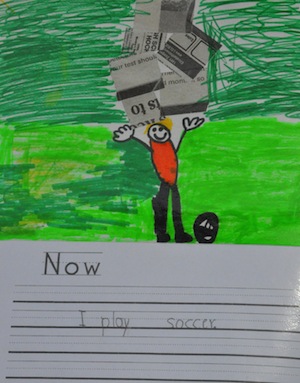 |
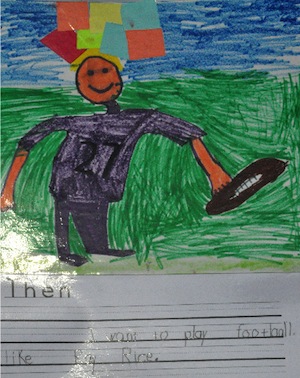 |
|
Figure 1. Ryan’s “Now” picture. |
Figure 2. Ryan’s “Then” picture. |
Ryan drew a picture of himself “now” playing soccer now with black/white thought bubbles. He wrote, “I play soccer.” His “then” (in the future) is him playing football wearing a Baltimore Ravens uniform, Ray Rice’s number 27 to be precise, with a brightly colored speech bubble. He wrote, “I want to play football like Ray Rice.” Ryan told me he knows how to play soccer now but hopes to be like Ray Rice “then”.
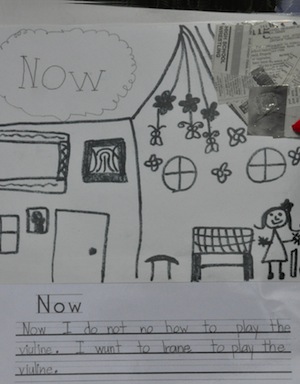 |
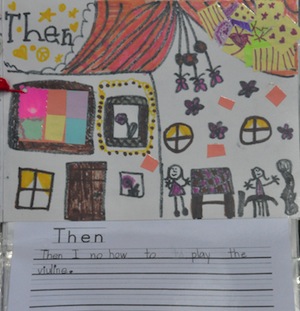 |
|
Figure 3. Avery’s “Now” picture. |
Figure 4. Avery’s “Then” picture. |
Avery’s now-then picture dealt with her learning to play the violin. Her “now” picture was in black and white picture of herself in her home with a newspaper mood bubble: “Now, I do not know how to play the violin. I want to learn to play the violin.” Her “then” picture was the same picture full of color and colorful tissue paper with designs, showing her playing the violin. Avery wrote, “Then I know how to play the violin.”
The following day we again discussed the connections we had with Sebastian and how he grew so much through the story and learned to do something on his own. Several children shared life experiences similar to his. I also showed the children my “Then and Now” pictures again, shared my story for my art, and allowed them time to ask me questions. I then modeled how today they would write about their art. To help them organize their thoughts, I gave the children time to turn and talk with a neighbor and tell the stories for their art. Then the children went to their seats and wrote.
On the third day the children added any final details and shared their art and writing. I was amazed how the children related to Sebastian. Jay, for example, said, “I practiced and practiced like Sebastian and learned something new” and Dylan said, “I was shy and didn’t raise my hand like Sebastian.”
Character X-Rays
When we finished reading books in the identity text set, the students had the opportunity to create a character x-ray of their identities. I gave the children a large blank character x-ray outline and asked them to write what others see about them on the outside and what is important to them inside the heart. The children showed insightful understandings of who they are through their x-rays.
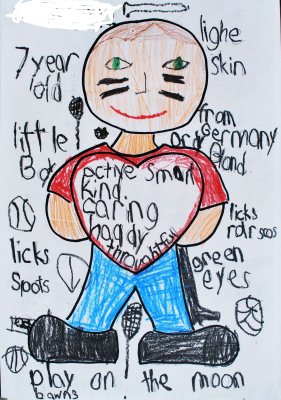 |
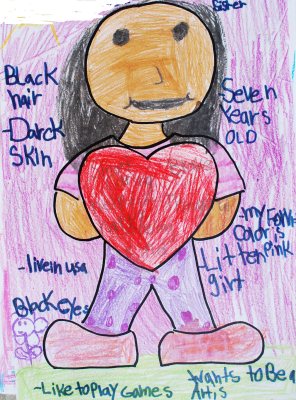 |
|
Figure 5. Jason’s character x-ray. |
Figure 6. Aeshah’s character x-ray. |
Jason’s love of sports is really clear on his x-ray. Around the outside he drew different pieces of sports equipment, such as a soccer ball, a baseball bat, a baseball, and a lacrosse stick, and even drew black lines under his eyes like football players have when they play. He also included his age, skin and eye color, and that his ancestors came from Germany. In his heart, he described himself as smart, active, kind, caring, happy, and truthful.
Around the outside of her character x-ray Aeshah shared such information as her age, her love of playing games, her desire to be an artist, and her hair, eye, and skin color. On the inside of her heart she wrote brave, helpful, thoughtful, happy, loving, and kind.
Through the many books in the identity text set that we read and discussed, the responses students created to the stories, and our character x-rays, students grew in their understandings of themselves as cultural beings. I also came to know and understand them, as well as myself, as cultural beings. They began to understand that who they are as people is complex, involving the type of person they are inside, as well as external characteristics.
References
Boelts, M. (2009). Those shoes. Illus. by N. Jones. Somerville, MA: Candlewick.
Chen, C. (2004). Guji, Guji. La Jolla, CA: Kane/Miller.
Chen, C. (2006). The featherless chicken. Alhambra, CA: Heryin Books.
Chinn, K. (1997). Sam and the lucky money. Illus. by C. Van Wright & Y. Hu. New York: Lee
and Low Books.
de Deu Prats, J. (2005). Sebastian’s roller skates. Illus. by F. Rovira. La Jolla, CA: Kane/Miller.
Garay, L. (1997). Pedrito’s day. New York: Orchard Books.
Mandelbaum, P. (1990). You be me, I’ll be you. La Jolla, CA: Kane/Miller.
Short, K. (2009). Critically reading the word and the world: Building intercultural understanding through literature. Bookbird: A Journal of International Children’s Literature, 47(2), 1-10.
Short, K., & Thomas, L. (2011). Developing intercultural understandings through global children’s literature. In R. Meyer & K. Whitmore (Eds.), Reclaiming reading: Teachers, students, and researchers regaining spaces for thinking and action (149-162). New York: Routledge.
Uegaki, C. (2005). Suki’s kimono. Illus. by S. Jorisch. Tonawanda, NY: Kids Can Press.
Laura Fuhrman teaches first grade at Pot Springs Elementary School in Maryland.
WOW Stories, Volume IV, Issue 5 by Worlds of Words is licensed under a Creative Commons Attribution-NonCommercial-ShareAlike 4.0 International License.
Based on a work at <a href="https://wowlit.org/on-line-publications/stories/iv5" target="_blank".
